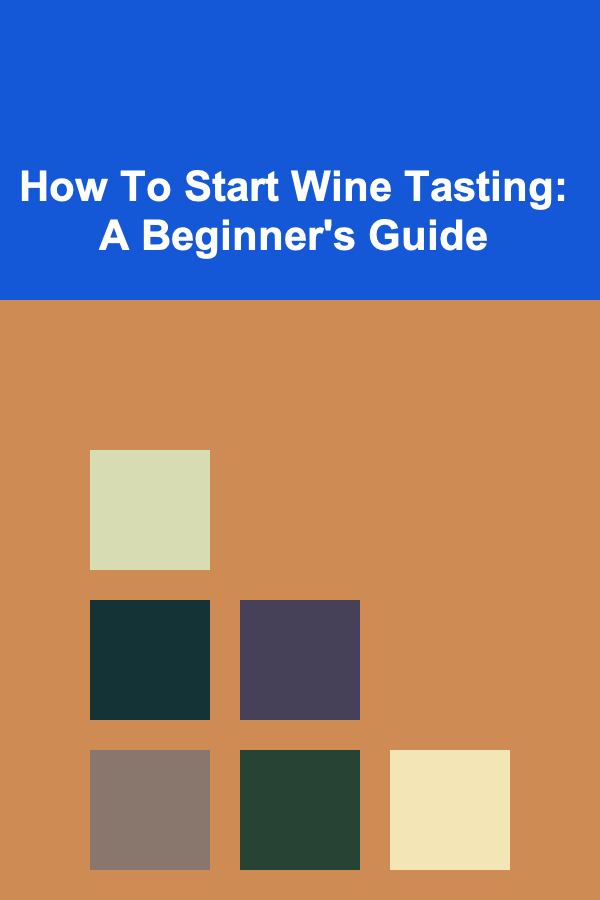
How To Start Wine Tasting: A Beginner's Guide
ebook include PDF & Audio bundle (Micro Guide)
$12.99$5.99
Limited Time Offer! Order within the next:

Wine tasting can seem intimidating. Words like "tannins," "terroir," and "legs" are thrown around, and experienced tasters seem to know things that are completely foreign to newcomers. However, anyone can learn to appreciate and understand wine. This guide will provide you with a comprehensive introduction to wine tasting, helping you develop your palate and enjoy the world of wine.
I. Understanding the Basics
Before diving into the tasting process, it's essential to understand some fundamental concepts about wine. This knowledge will provide a solid foundation for your tasting journey.
A. Grape Varieties: The Building Blocks
Wine is made from grapes, and the variety of grape used significantly impacts the wine's flavor, aroma, and characteristics. Here are some popular grape varieties:
- Red Grapes:
- Cabernet Sauvignon: Known for its black currant, cedar, and sometimes green bell pepper notes. Often full-bodied and high in tannins.
- Merlot: Softer and fruitier than Cabernet Sauvignon, with flavors of red cherry, plum, and chocolate.
- Pinot Noir: A delicate and complex grape with flavors of red fruit (cherry, raspberry), earth, and sometimes mushroom. Often lighter-bodied.
- Syrah/Shiraz: Depending on the region, can exhibit flavors of blackberry, pepper, smoke, and even bacon.
- Malbec: Rich and fruity with flavors of blackberry, plum, and violet. Often has a smooth, velvety texture.
- White Grapes:
- Chardonnay: A versatile grape that can range from crisp and citrusy (unoaked) to rich and buttery (oaked).
- Sauvignon Blanc: Known for its herbaceous and grassy notes, along with flavors of grapefruit, passionfruit, and gooseberry.
- Riesling: Aromatic and high in acidity, with flavors of green apple, apricot, and honey. Can range from dry to sweet.
- Pinot Grigio/Gris: Light-bodied and crisp, with flavors of lemon, green apple, and pear.
- Gewürztraminer: Aromatic and spicy, with flavors of lychee, rose petals, and grapefruit.
Wine Tip:
Start by focusing on a few grape varieties that appeal to you. As you taste more wines made from those grapes, you'll begin to recognize their characteristic flavors and aromas.
B. Wine Regions: The Influence of Terroir
Terroir is a French term that refers to the environmental factors that influence a wine's characteristics, including the soil, climate, topography, and even the winemaking traditions of a particular region. Understanding terroir can help you appreciate the nuances of different wines.
- Examples of Important Wine Regions:
- Bordeaux (France): Known for its Cabernet Sauvignon and Merlot blends.
- Burgundy (France): Famous for its Pinot Noir and Chardonnay wines.
- Napa Valley (California, USA): Renowned for its Cabernet Sauvignon.
- Sonoma County (California, USA): Produces a wide variety of wines, including Pinot Noir, Chardonnay, and Zinfandel.
- Tuscany (Italy): Home to Chianti, made primarily from Sangiovese grapes.
- Rioja (Spain): Known for its Tempranillo-based wines.
- Marlborough (New Zealand): Famous for its Sauvignon Blanc.
The climate, for example, plays a massive role. Warmer climates generally produce wines with higher alcohol content and riper fruit flavors, while cooler climates often result in wines with higher acidity and more subtle flavors.
C. Basic Wine Styles: A Broad Overview
Wines can be broadly categorized into different styles based on their color, body, sweetness, and effervescence.
- Red Wine: Made from dark-skinned grapes. The skins are left in contact with the juice during fermentation, giving the wine its color, tannins, and complex flavors.
- White Wine: Typically made from white or green grapes. The skins are usually removed before fermentation, resulting in a lighter-bodied wine with delicate flavors.
- Rosé Wine: Made from red grapes, but the skins are only left in contact with the juice for a short period, resulting in a pink-colored wine. Rosé wines can range from dry to sweet.
- Sparkling Wine: Wine that contains significant levels of carbon dioxide, making it bubbly. Examples include Champagne, Prosecco, and Cava.
- Dessert Wine: Sweet wines that are often enjoyed with desserts. They can be made from late-harvest grapes, grapes affected by noble rot (Botrytis cinerea), or fortified with spirits.
II. The Tasting Process: The 5 S's
The process of tasting wine involves using your senses of sight, smell, and taste to evaluate the wine's characteristics. A simple mnemonic device to remember the steps is the "5 S's": See, Swirl, Smell, Sip, Savor.
A. See: Visual Examination
The appearance of a wine can provide valuable clues about its age, grape variety, and winemaking style.
- Color: Hold the glass against a white background and observe the wine's color.
- Red Wine: Young red wines tend to be deep purple or ruby red, while older red wines may have a brick red or garnet color.
- White Wine: Young white wines are often pale yellow or straw-colored, while older white wines may have a golden or amber hue.
- Rosé Wine: Rosé wines can range from pale pink to salmon-colored.
- Clarity: The wine should be clear and free of sediment (unless it's an unfiltered wine).
- Legs (Tears): Swirl the wine and observe the streaks that form on the inside of the glass. These "legs" or "tears" indicate the wine's alcohol content and sugar levels. Thicker, slower-moving legs usually suggest a higher alcohol content or more residual sugar. While often mistakenly thought of as an indicator of quality, legs primarily relate to the alcohol content and viscosity.
B. Swirl: Aeration and Aroma Release
Swirling the wine allows it to come into contact with more oxygen, which releases its aromas and allows you to better appreciate its bouquet. Gently swirl the wine in your glass, avoiding spilling it.
Wine Tip:
Practice swirling without spilling by starting with water in your glass. Once you're comfortable, you can move on to wine!
C. Smell: The Bouquet and Aromas
The aroma of a wine is often its most complex and intriguing characteristic. Aromas can be categorized into several groups:
- Primary Aromas: These aromas come directly from the grape and include fruit (berries, citrus, stone fruit), floral (rose, violet, lavender), and herbal (grass, mint, eucalyptus) notes.
- Secondary Aromas: These aromas are derived from the winemaking process, such as fermentation and aging. They include notes of yeast, bread, butter (from malolactic fermentation), vanilla, oak, and spice.
- Tertiary Aromas: These aromas develop as the wine ages in the bottle and include notes of earth, leather, tobacco, mushroom, and dried fruit.
To properly smell the wine, hold your nose close to the glass and take short, quick sniffs. Try to identify the different aromas and make note of them.
Here are some common aromas to look for:
- Red Fruits: Cherry, raspberry, strawberry, cranberry
- Black Fruits: Blackberry, plum, black currant
- Citrus Fruits: Lemon, lime, grapefruit
- Stone Fruits: Peach, apricot, nectarine
- Floral Notes: Rose, violet, lavender, jasmine
- Herbal Notes: Grass, mint, eucalyptus, thyme
- Spice Notes: Pepper, clove, cinnamon, nutmeg
- Earthy Notes: Mushroom, forest floor, truffle
- Oak Notes: Vanilla, toast, cedar, smoke
D. Sip: The First Impression
Take a small sip of wine and let it coat your entire mouth. Pay attention to the wine's texture, weight, and initial flavors.
- Sweetness: Is the wine dry, off-dry, or sweet?
- Acidity: Does the wine make your mouth water? Is it tart or refreshing?
- Tannins: (Primarily in red wines) Do you feel a drying sensation in your mouth? Are the tannins smooth or astringent?
- Body: Is the wine light-bodied, medium-bodied, or full-bodied?
- Flavors: What flavors do you perceive on the palate? Do they match the aromas you detected earlier?
Wine Tip:
Don't be afraid to look silly! Some tasters will slightly chew or "mull" the wine to further release aromas and flavors.
E. Savor: The Finish and Aftertaste
After swallowing (or spitting, if you're tasting multiple wines), pay attention to the wine's finish -- the lingering flavors and sensations that remain in your mouth. A long and complex finish is often a sign of a high-quality wine.
- Length: How long does the finish last?
- Complexity: Does the finish evolve or remain the same?
- Balance: Are the flavors and sensations in harmony?
III. Practical Tips for Wine Tasting
To enhance your wine tasting experience and develop your palate, consider the following tips:
A. Choosing the Right Glassware
The shape of a wine glass can significantly impact the wine's aromas and flavors. Here are some general guidelines:
- Red Wine Glasses: Typically have a larger bowl to allow the wine to breathe and release its aromas.
- White Wine Glasses: Often have a smaller bowl to concentrate the wine's delicate aromas and maintain its cooler temperature.
- Sparkling Wine Glasses (Flutes): Tall and narrow to preserve the wine's bubbles and enhance its visual appeal.
Investing in a set of good-quality wine glasses can greatly improve your tasting experience. A universal wine glass shape can work for both reds and whites if you don't want to invest in multiple styles.
B. Serving Temperature
Serving wine at the correct temperature is crucial for maximizing its flavor and aroma. Too warm, and the alcohol can overpower the other flavors. Too cold, and the flavors can be muted.
- Red Wine: Generally served at a slightly cool room temperature (60-65°F or 15-18°C). Lighter-bodied reds can be served slightly cooler (55-60°F or 13-15°C).
- White Wine: Typically served chilled (45-55°F or 7-13°C). Lighter-bodied whites and sparkling wines should be served colder than full-bodied whites.
- Rosé Wine: Served chilled (45-55°F or 7-13°C).
A wine thermometer can be helpful for ensuring accurate serving temperatures. Consider chilling reds briefly in the refrigerator before serving, especially during warmer months.
C. Food and Wine Pairing
Pairing wine with food can elevate both the wine and the meal. Here are some basic principles to keep in mind:
- Match the weight of the wine to the weight of the food. Light-bodied wines pair well with light dishes, while full-bodied wines pair well with richer dishes.
- Consider the flavors. Look for wines that complement or contrast the flavors of the food. For example, a crisp Sauvignon Blanc can pair well with a goat cheese salad, while a rich Cabernet Sauvignon can complement a grilled steak.
- Match acidity. Acidic wines pair well with fatty or rich foods. The acidity cuts through the fat and cleanses the palate.
- Consider sweetness. Sweet wines pair well with desserts or spicy foods.
- Tannins and Protein. Red wines with high tannins pair well with protein-rich foods, such as red meat. The tannins bind to the proteins, softening the tannins and creating a more pleasant mouthfeel.
Don't be afraid to experiment! The best way to learn about food and wine pairing is to try different combinations and see what you enjoy.
D. Taking Notes
Keeping a wine tasting journal can be a valuable tool for tracking your progress and developing your palate. Record the name of the wine, the vintage, the grape variety, the region, and your tasting notes. Be as specific as possible when describing the aromas, flavors, and textures you perceive.
Here are some prompts to guide your note-taking:
- Appearance: Color, clarity, legs
- Aroma: Primary, secondary, and tertiary aromas
- Palate: Sweetness, acidity, tannins, body, flavors
- Finish: Length, complexity, balance
- Overall Impression: How did you enjoy the wine? Would you recommend it?
Over time, you'll develop a personal vocabulary for describing wines and gain a better understanding of your own preferences.
E. Expanding Your Knowledge
There are many resources available to help you expand your knowledge of wine:
- Books: There are countless books on wine, covering topics such as grape varieties, regions, winemaking techniques, and food pairing.
- Websites and Blogs: Many websites and blogs offer reviews, articles, and educational resources about wine.
- Wine Courses and Classes: Taking a wine course or class can provide you with a structured learning environment and the opportunity to taste a wide variety of wines.
- Wine Tasting Events: Attending wine tasting events is a great way to sample different wines, meet other wine enthusiasts, and learn from experts.
- Visits to Wineries: Visiting wineries allows you to see firsthand how wine is made and to learn about the terroir and winemaking traditions of a particular region.
IV. Common Mistakes to Avoid
New wine tasters often make a few common mistakes. Being aware of these can help you improve your tasting skills and avoid pitfalls.
A. Overthinking It
Wine tasting should be an enjoyable experience. Don't get too caught up in trying to identify every single aroma or flavor. Focus on the overall impression of the wine and what you enjoy about it. Relax and have fun!
B. Using the Wrong Glassware
As mentioned earlier, the shape of the glass can significantly impact the wine's aromas and flavors. Using the wrong glass can hinder your ability to appreciate the wine fully. Use the appropriate glassware for the type of wine you're tasting.
C. Serving Wine at the Wrong Temperature
Serving wine at the wrong temperature can mask its flavors and aromas. Ensure that you serve the wine at the recommended temperature for its style.
D. Not Paying Attention to the Details
Take the time to carefully observe the wine's appearance, aroma, and flavor. Pay attention to the details and try to identify the different characteristics. This will help you develop your palate and improve your tasting skills.
E. Being Afraid to Ask Questions
Don't be afraid to ask questions! Wine professionals are usually happy to share their knowledge and help you learn more about wine. Whether you're at a wine tasting event, a winery, or a restaurant, don't hesitate to ask questions about the wine's characteristics, winemaking techniques, or food pairing suggestions.
V. Conclusion
Starting your wine tasting journey can be an exciting and rewarding experience. By understanding the basics of wine, learning the tasting process, and practicing regularly, you can develop your palate and gain a deeper appreciation for the world of wine. Remember to relax, have fun, and explore the wide variety of wines available. Cheers to your wine adventure!

How to Care for Your Pet's Teeth to Ensure Good Oral Health
Read More
How to Create a Family Emergency Plan for Home Security
Read More
How to Create a Harmonious Living Space with Balanced Furniture
Read More
How to Organize Your Garage with Minimal Cost
Read More
How to Use a Bulletin Board for Family Communication
Read More
How to Find TV Shows That Are Genuinely Scary
Read MoreOther Products

How to Care for Your Pet's Teeth to Ensure Good Oral Health
Read More
How to Create a Family Emergency Plan for Home Security
Read More
How to Create a Harmonious Living Space with Balanced Furniture
Read More
How to Organize Your Garage with Minimal Cost
Read More
How to Use a Bulletin Board for Family Communication
Read More